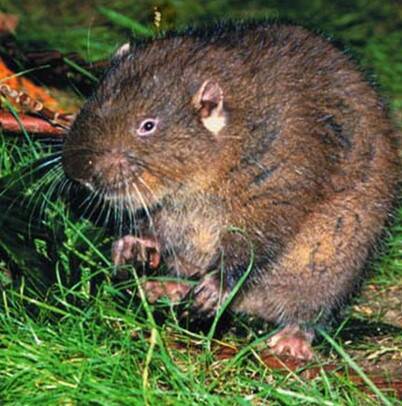Question: I recently awoke to a devastating sight: Over half the plants in my zinnia patch had been clipped to the ground. To add insult to injury, I found the plants only a short distance away spread over some salal. Was this a cruel prank?
Answer: Sadly, I think you (or rather your zinnia patch) have fallen victim to a busy mountain beaver.
The mountain beaver (scientific name: Aplodontia rufa) is a medium-sized rodent (average weight 2.3 pounds) found only in the Pacific coastal region of Washington, Oregon, California and British Columbia. It can wreak havoc in a home garden and cause considerable damage at a tree farm.
Mountain beavers neither live in the mountains nor are related to beavers. With a stout, compact body and reddish-brown to gray fur (see photo), they look somewhat like a muskrat that has parted with its tail. Their closest relatives are in the squirrel family.
Mountain beavers build extensive underground burrows that are 6 to 8 inches in diameter with multiple entryways, passages and specialized chambers. The burrows are generally half a foot to 6-feet deep and can be distinguished from those of other animals by their large diameter and piles of excavated soil near the entrance.
Mountain beavers are seldom seen but can cause considerable damage to a landscape. Rhododendrons, roses, vegetables, trees, berry bushes, ferns, and zinnias are just a few of the plants that disappear after a visit from a mountain beaver. Most feeding occurs within 50 feet of a burrow entrance.
Mountain beavers typically clip smaller plants off at the base and climb larger trees to cut off branches.
They also girdle older trees at the base. Mountain beavers frequently leave the purloined plant material in piles outside the entrance to their burrow and drag it inside after it has dried.
Control of a mountain beaver problem can be difficult. Trapping is often recommended but is impractical for homeowners: Lethal body gripping traps and relocation of animals caught in live traps require special permits. Poisons with proven effectiveness against mountain beavers can only be used by certified pesticide applicators or persons under their direct supervision. Fumigants, such as carbon monoxide, are generally ineffective because of the open, well-ventilated structure of the mountain beaver burrow system.
The Washington Department of Fish and Wildlife suggests harassment as a first step in dealing with this garden menace. When new burrows are discovered, stuff the entry holes with rocks, balled-up window screen or rags sprinkled with predator urine (e.g., mink, coyote or bobcat urine that is available through the internet) or ammonia.
Exclusion is also an option. A wire fence constructed of 2-inch-by-2-inch mesh that is at least 2 feet high usually keeps them out. Burying the lower portion of the fence or fastening it securely to the ground is essential.
These measures encourage mountain beavers to build their burrows elsewhere. But when one mountain beaver vacates an area, another is soon to follow. As a result, the success of these control measures depends on persistence from the harasser (aka the gardener). Good luck!
Question: Are eating microgreens a health risk? I have heard that sprouts have been linked to foodborne disease outbreaks and wonder if microgreens are also risky.
Answer: Microgreens are vegetables and herbs that are harvested when they are very young and tender soon after the first true leaves emerge (10-14 days after germination). They are usually grown in shallow trays of soil and do best if exposed to light and good air circulation. Only the leaves and stems of microgreens are eaten, not the roots.
In contrast, sprouts are grown in a warm, moist environment without soil. They have limited exposure to light and air circulation. They are allowed to germinate and are harvested before the first true leaves emerge; they are eaten roots and all.
Outbreaks of Salmonella, E. coli and other bacteria have been linked to commercially produced sprouts. The increased risk has been attributed to the warm, moist conditions used to grow sprouts that also allow bacteria on the seed or in the growing environment to multiply sufficiently to cause disease.
Because microgreens grow in soil that could be contaminated with disease-causing bacteria and are difficult to wash, they, too, could present a risk for foodborne diseases.
It is generally felt, however, that they are not as risky as sprouts because they are exposed to more ventilation and sunlight that would discourage the multiplication of bacteria.
To date, microgreens have not been associated with any outbreaks, but commercially produced microgreens have been recalled from the market because of food safety concerns.
To minimize the risk of a foodborne disease when growing microgreens at home, follow these tips:
1. Use soil and soil amendments that are sterilized, properly composted or otherwise determined to be free of disease-causing microorganisms.
2. Provide good growing conditions for the plants that include adequate light and good air circulation.
3. Use potable water to irrigate the microgreens. Watering from the bottom might help keep the tender leaves cleaner.
4. Harvest the microgreens by cutting them with clean scissors or a clean sharp knife when they are 1 to 2 inches tall and have their first true leaves. Do not disturb the soil or the roots.
5. Refrigerate the microgreens as soon as possible.
6. Wash the microgreens thoroughly before eating but minimize handling as these greens are tender and easily damaged.
For more information on growing microgreens safely see “Microgreens and Produce Safety” by the University of Nevada Extension at extension.unr.edu/publication.aspx?PubID=3468.
Jeanette Stehr-Green is a WSU-certified Clallam County Master Gardener.
Plant clinics can help
For more free gardening help visit a local Master Gardener plant clinic. Clinics are held on Mondays from 9:30 a.m.-12:30 p.m. through Oct. 30 at the Clallam County Courthouse, 223 E. Fourth St., Port Angeles). You can also submit gardening questions by email at mgplantclinic.clallam@gmail.com or by calling the Help Line at 360-417-2514.



